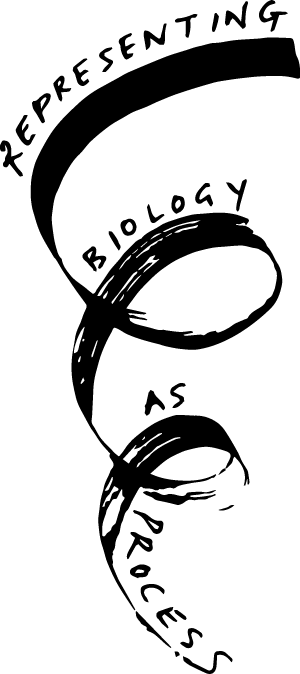‘Representing Protein Dynamics’
ISHPSSB Oslo 7–12 July 2019
John Dupré, Gemma Anderson and JJ Phillips
This session derives from our AHRC (Arts and Humanities Research Council, UK) funded project, ‘Representing Biology as Process’ (https://www.probioart.uk), which, in turn, grew out of John Dupré’s ERC-funded project, A Process Ontology for Contemporary Biology. The latter project developed the argument that Biological Systems of all kinds should be understood as processes rather than substances or things. This raised questions about the best ways of visually representing biological systems without occluding their dynamic nature.
Core members of the interdisciplinary team are Dupré, artist Gemma Anderson, and cell biologist James Wakefield, and the team will address problems of representation across a range of biological scales. Anderson has been collaborating with a diverse range of scientists for several years, and following pioneering work by artists such as Paul Klee, she has had a longstanding interest in representing transformation through two-dimensional images. The first, largely completed, target of the present project was mitosis, especially the energetic body of spindle formation. Anderson and Wakefield collaborated in generating a series of entirely novel images of mitosis, and the team continues to work on exploring the meaning and utility of these images.
The current phase of the project addresses protein dynamics, especially the energy landscape associated with protein folding, and Anderson is collaborating on this with protein biophysicist Jonathan Phillips. The conventional image for representing protein dynamics in biology is the ‘Folding funnel’, an irregular, broadly conical shape that corresponds to an energy landscape down which the protein is imagined to flow as its structure achieves lower energy formations. While this image represents some features well, others are obscured.
The proposed presentation at ISHPSSB, Oslo will describe the methods of interdisciplinary collaboration and the objectives of the project, and then present the images developed for protein folding and some discussion of their significance. As with the mitosis project, a number of novel modes of representation are being explored. We will present a series of new images that function as visual metaphor for the protein energy landscape – as process – based on a maze structure, and experiment with the maze as a metaphor for process beyond proteins, such as mitosis and speciation. Anderson, Phillips and Dupré will jointly present this work, providing scientific, art-theoretic and philosophical perspectives on the project and its results.
